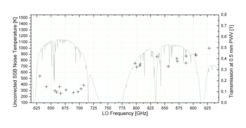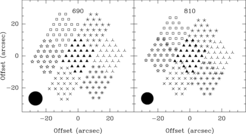Key Facts for CHAMP+ Observers
Instrument performance
The array composes of 2 × 7 pixels that operate simultaneously in the RF tuning range of 620–720 GHz in the low (LFA) and 780–950 GHz in the high frequency (HFA) sub-array, respectively. The beam-spacing is ~2.15·qmb for both sub-arrays, with half-power beam widths of 8.8'' (at 692 GHz) and 7.7'' (806 GHz).
Single sideband (SSB) noise temperatures of the 14 pixels, displayed below, translate for a good submm transmission at Chajnantor (PWV 0.3 – 0.5mm, 60° elevation) into SSB system temperatures of typically 1000–1400 (at the frequency of the CO(6–5) line at 691 GHz) and 2500–4000 (CO(7–6) at 806 GHz, closer to the edge of the atmospheric window). The image gain suppression was better than 10-15 dB for all pixels (in the center of the IF band).
Allan Variance measurements of the complete system - during normal telescope movements - reveal an excellent stability exceeding 100 - 150 secs in all channels.

The IF processor serves all 14 individual modules, separating the 4 – 8 GHz CHAMP+ front-end signal into two 1.5 GHz wide sub-bands. Both of these sub-bands are independently amplified and down-converted to baseband (0–1.5 GHz) for further processing by the FFT array-backend. The standard set-up allows for a 200 MHz wide overlap between the two sub-bands, so that the total bandwidth per mixer available for observations is ~2.8 GHz (optional: 2.4 and 2.6 GHz, with correspondingly wider overlap). The usable bandwidth at the band edges is limited by the finite response of our anti-aliasing filters (17 dB suppression at 50 MHz offset).
| Bandwidth per IF | 1.5 GHz |
| Number of spectral channels per IF | 8192 |
| Spectral resolution (ENBW) | 212 kHz |
Operation on sky
The prime observing modes for the CHAMP+ array are staring, raster and on-the-fly observations, all of which can be used with or without the wobbler switched on.

Example of a "hexagonal" raster mode with 25 positions (LFA to the left, HFA to the right). The raster step between two positions in the horizontal direction is 3.75''. Each pixel is shown with a different symbol. This mode produces a few redundant observations for the 810 GHz sub-array, but ensures that, despite the slightly asymmetric footprint of the sub-arrays, full sampling is achieved for both sub-arrays for any rotation of the dewar.
- For compact objects with angular sizes smaller than the beam, the most efficient mode is the staring or total power mode, in which the source is observed by only one (generally, the central) pixel from each sub-array.
- For extended objects that are still smaller than the footprint of the array, raster observations can be employed with different samplings. From the hexagonal symmetry of the sub-arrays, it is clear that the most efficient rasters are hexagonal as well. A snapshot-like one-beam sampling can be obtained with a raster comprising the center and three outer positions of a one-beam separated hexagon. A close to fully-sampled map is obtained by extending the latter mode to 16 positions. Due to the average spacing being slightly larger than two beam widths, a hexagonal raster with more positions is needed for a true fully-sampled coverage. Below, the coverage of a fully sampled mode with 25 positions is displayed, leading to a few redundant observations of positions within the footprint of the HF sub-array.
- For sources with sizes comparable or larger than the footprint of the array, continuous on-the-fly (OTF) observations become the most efficient observing mode. Compared to the hexagonal raster modes, OTF modes have larger losses or undersampled areas at the edges of the maps, but gain in efficiency by eliminating the dead times between different positions in raster observations. Fully sampled OTF maps are obtained by observing with the array rotated by 19.1 with appropriate stepping of subsequent OTF rows. This also ensures that each part of the sky is being observed with several different pixels, resulting very uniform images. In addition to the traditional continuous OTF data acquisition, one can of course also perform discrete integrations rasters) in steps along the scanning directions (this can be combined with wobbler switching).
Instrument status
As a PI instrument, CHAMP+ will undergo continuous upgrades. We will document here the actual status of the instrument after start of the 2009 observing season (CHAMP+ operation will start in June).
| Status of CHAMP+ | |
| 01.01.2009 | Operation Shutdown |
| xx.xx.2009 | |
One lesson from previous CHAMP+ operations has been that the accuracy of the pointing model of the telescope is often insufficient for blind pointing across the sky (this is painfully true away from the galactic plane, where we often have a choice of compact hot core continuum sources to peak-up). The all-sky pointing r.m.s. as routinely achieved for the facility receivers in the Cassegrain and Nasmyth A cabins is ~2–3'', which for the 7'' beam of CHAMP+ in its high-frequency channel is inadequate. While the APEX project is working to further improve the pointing behaviour of the facility, you have to take this boundary into account when preparing an observing proposal.

